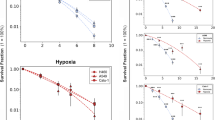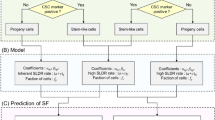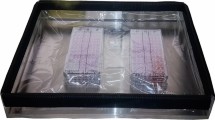Abstract
Purpose
The effect of ionizing radiation on multidrug resistance (MDR) of human larynx cancer HEp-2 cells has been investigated. We studied the dependence of the radiation effect on radiation dose, time after irradiation and cell density.
Methods
MDR was determined from an increase in cell sensitivity to daunorubicin, taxol and vincristine by the inhibitors of multidrug resistance cyclosporin A and avermectin B1, and from the suppression by cyclosporin A of the transport of rhodamine 123 out of the cells. The cells were irradiated with X-ray beams (dose rate 1.12 Gy min−1) at room temperature.
Results
It was shown that, at 8 and 16 h after irradiation with doses up to 4 Gy, the multidrug resistance of cells increases, and at 24 h it decreases to the control level. The effect was maximal by 16 h after irradiation with a dose of 1 Gy. Both, the contribution of active transport to the rate of rhodamine 123 efflux from cells and their resistance to vincristine, increased. The effect of irradiation on multidrug resistance of HEp-2 cells depended on the density of cells on the substrate, being maximal at a density of 80,000–100,000 cm−2.
Conclusion
The irradiation-induced changes in the MDR of tumor cells should be taken into account when combining radiotherapy with chemotherapy. It was assumed that the dependence of multidrug resistance of HEp-2 cells on radiation dose and cell density is determined by changes in the amount of reactive oxygen species in the cells.







Similar content being viewed by others
References
Harvie RM, Davie MV, Davey RA (1997) Increased MRP expression is associated with resistance to radiation, anthracyclines and etoposide in cells treated with fractionated gamma-radiation. Int J Cancer 73:164–167
Trog D, Moenkemann H, Haertel N, Schuller H, Golubnitschaja O (2005) Expression of ABC-1 transporter is elevated in human glioma cells under irradiation and temozolomide treatment. Amino Acids 28:213–219
Korystov YN, Ermakova NV, Shaposhnikova VV, Levitman MK, Kim YA, Pushkin SY (2006) Perftoran injection into p388 ascitic lympholeucosis mouse tumor decreases the number of tumor cells and their multidrug resistance. Biol Membranes 23:22–26
Wartenberg M, Ling FC, Muschen M, Klein F (2003) Regulation of the multidrug resistance transporter P-glycoprotein in multicellular tumor spheroids by hypoxia-inducible factor-1 and reactive oxygen species. FASEB J 17:503–505
Castro AF, Horton JK, Vanoye CG, Altenberg GA (1999) Mechanism of inhibition of P-glycoprotein-mediated drug transport by protein kinase C blockers. Biochem Pharmacol 58:1723–1733
Shtil AA (2003) Development of cellular multidrug resistance in response to exogenous stimuli. Biol Membranes 20:236–243
Yang JM, Chin KV, Hait WN (1995) Involvement of phospholipase C in heat-shock-induced phosphorylation of P-glycoprotein in multidrug resistant human breast cancer cells. Biochem Biophys Res Commun 210:21–30
Miao Z-H, Ding J (2003) Transcription factor c-Jun activation represses mdr-1 gene expression. Cancer Res 63:4527–4532
Ogretmen B, Safa A (1999) Negative regulation of MDR-1 promoter activity in MCF-7, but not in multidrug resistant MCF-7/Adr cells by cross-coupled NF-kB/p65and c-Fos transcription factors and their interaction with the CAAT region. Biochemistry 38:2189–2199
Leach JK, Van Tuyle G, Lin P-S, Schmidt-Ullrich R, Mikkelsen RB (2001) Ionizing radiation-induced, mitochondria-dependent generation of reactive oxygen/nitrogen. Cancer Res 61:3894–3901
Churchill JR, Chu AM, Bullon AE, Chou RH, Kim S (1991) Early induction of c-myc mRNA by ionizing radiation in human promielocytic leukemia (HL-60) cells. J Cell Biol 115:412–418
Lee YJ, Galoforo SS, Berns CM, Erdos G, Gupta AK, Ways DK, Corry PM (1995) Effect of ionizing radiation on AP-1 binding activity and basic fibroblast growth factor gene expression in drug-sensitive human breast carcinoma MCF-7 and multidrug-resistant MCF-7/ADR cells. J Biol Chem 270:28790–28796
Woloschak GE, Chang-Liu CM, Jones PS, Jones CA (1990) Modulation of gene expression in Syrian hamster embryo cells following ionizing radiation. Cancer Res 50:339–344
Kini CY, Giaccia AJ, Strubovici B, Brown JM (1992) Differential expression of protein kinase C3 protein in lung cancer cell lines by ionizing radiation. Br J Cancer 66:844–849
Korystov YN (1995) Cross-linking of surface receptors as a trigger of cell apoptosis and proliferation. Scan Microsc 9:757–762
Wielinga PR, Heijn N, Westerhoff HW, Lankelma J (1998) A method for studying plasma membrane transport with intact cells using computerized fluorometry. Ann Biochem 263:221–231
Wielinga PR, Westerhoff HV, Lankelma J (2000) The relative importance of passive and P-glycoprotein mediated antracycline efflux from multidrug-resistant cells. Eur J Biochem 267:649–657
Korystov YN, Ermakova NV, Kublik LN, Levitman MK, Shaposhnikova VV, Mosin VA, Drinyaev VA, Kruglyak EB, Novik TS, Sterlina TS (2004) Avermectins inhibit multidrug resistance of tumor cells. Eur J Pharmacol 493:57–64
Elledge SJ (1996) Cell cycle checkpoints preventing an identity crisis. Science 274:1664–1662
Boag J (1969) Oxygen diffusion and oxygen depletion problems in radiobiology. Curr Top Radiat Res 5:141–195
Ermakova NV, Shaposhnikova VV, Levitman MK, Kim YA, Korystov YN (2004) Alternation of multidrug resistance of vincristine-resistant lympholeukosis P388 cells in the case of ascitic tumor growth. Biol Membranes 21:102–106
Wartenberg M, Fisher K, Hescheler J, Sauer H (2000) Redox regulation of P-glycoprotein-mediated multidrug resistance in multicellular prostate tumor spheroids. Int J Cancer 85:267–274
Acknowledgments
This work was supported by the Russian Foundation for Basic Research (project no. 05-04-48840).
Author information
Authors and Affiliations
Corresponding author
Rights and permissions
About this article
Cite this article
Korystov, Y.N., Shaposhnikova, V.V., Korystova, A.F. et al. Modification of multidrug resistance of tumor cells by ionizing radiation. Cancer Chemother Pharmacol 61, 15–21 (2008). https://doi.org/10.1007/s00280-007-0439-2
Received:
Accepted:
Published:
Issue Date:
DOI: https://doi.org/10.1007/s00280-007-0439-2




